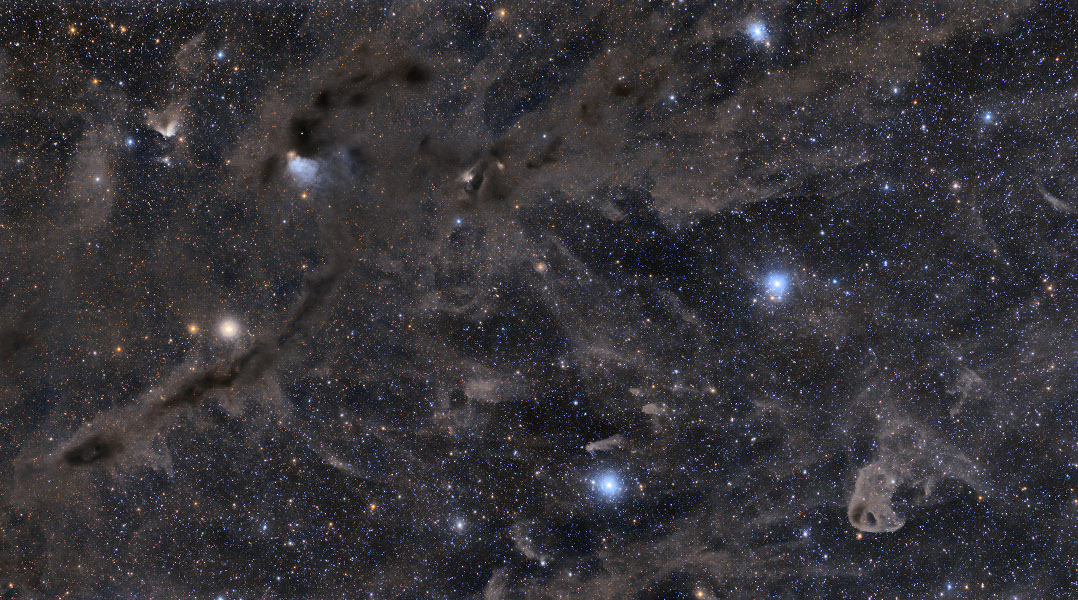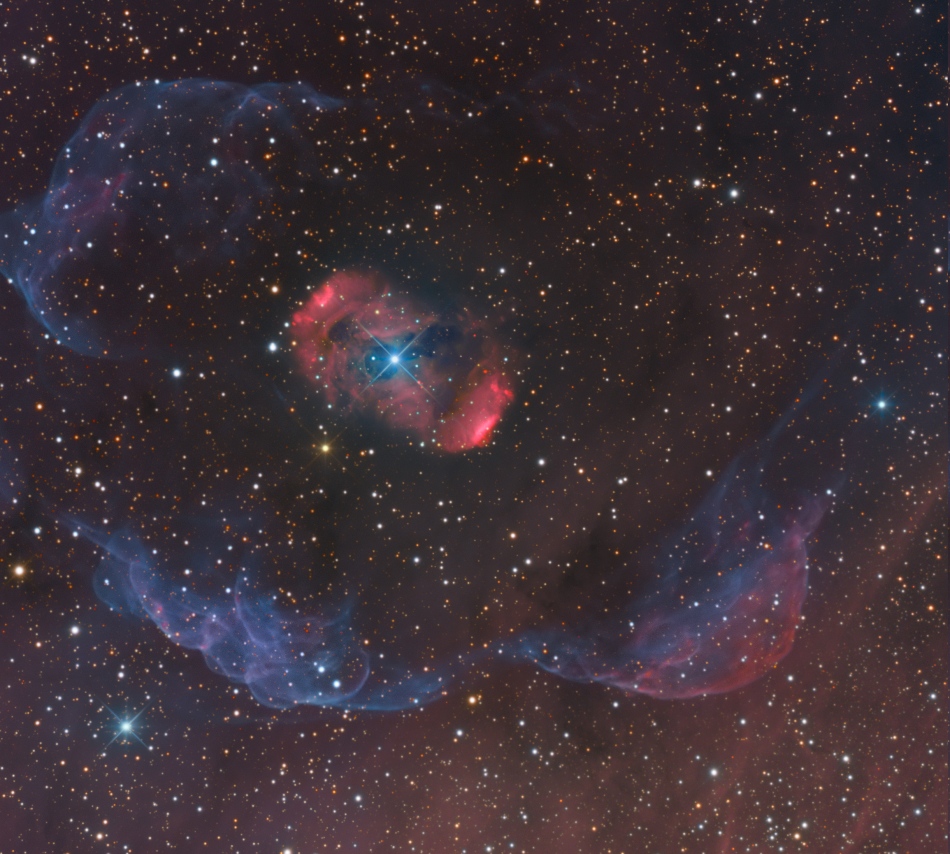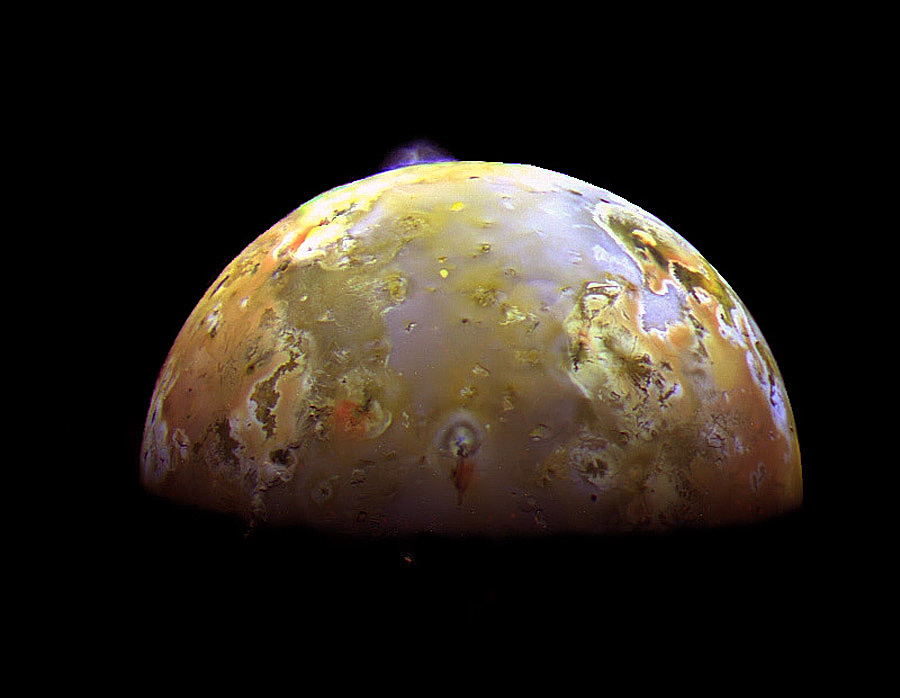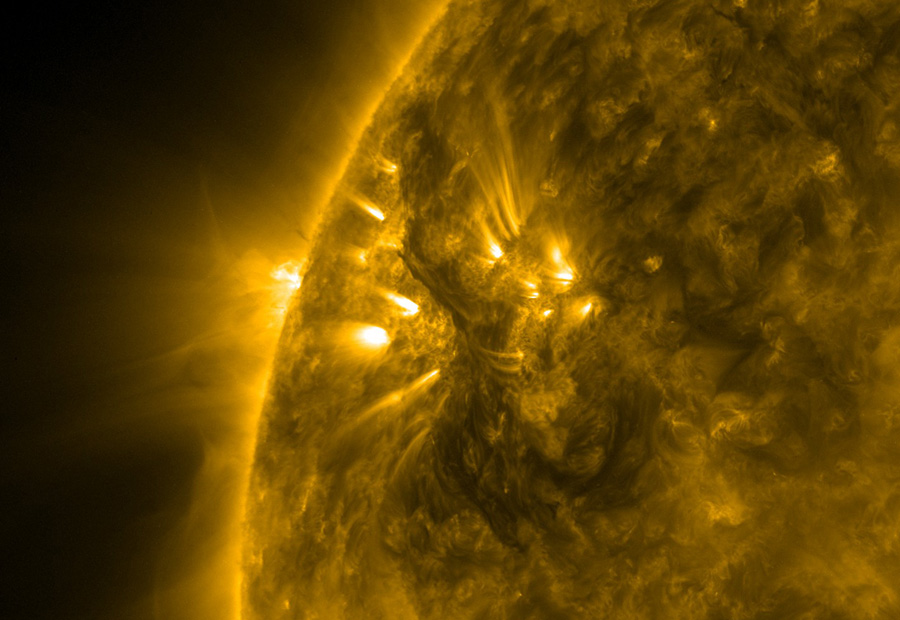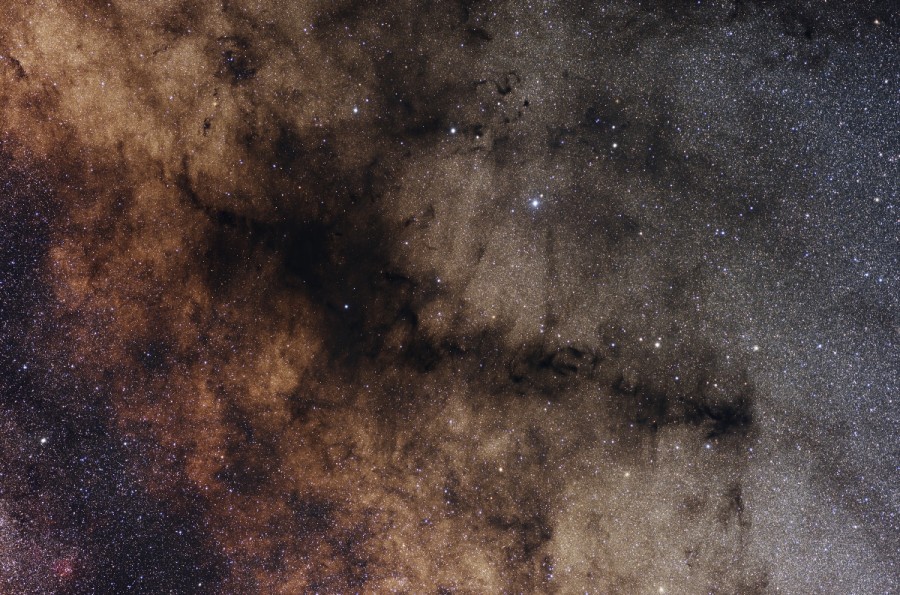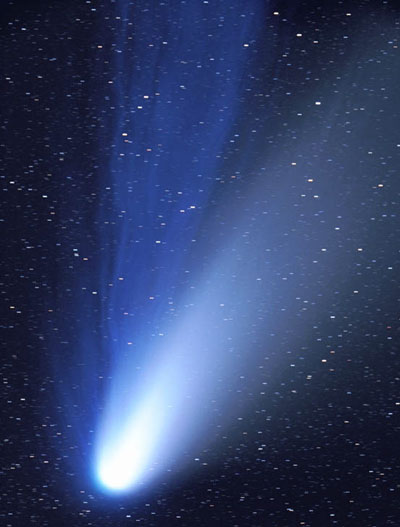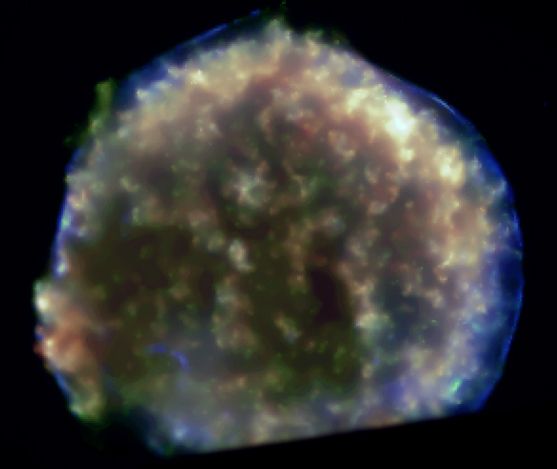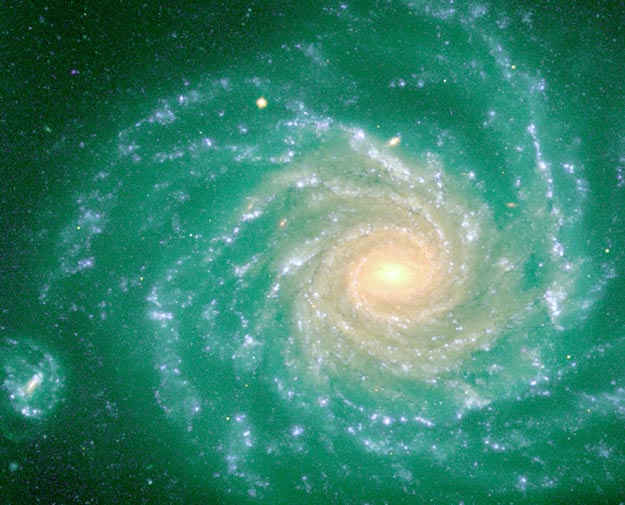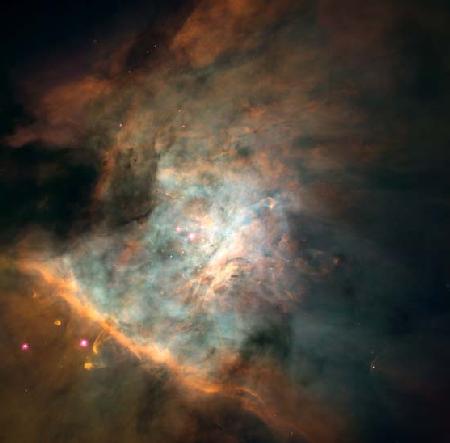| << Previous | Index | Next >> |
2015 In the dusty sky toward the constellation Taurus and the Orion Arm of our Milky Way Galaxy, this broad mosaic follows dark and faint reflection nebulae along the region's fertile molecular cloud. The six degree wide field of view starts with long dark nebula LDN 1495 stretching from the lower left, and extends beyond the (upside down) bird-like visage of the Baby Eagle Nebula, LBN 777, at lower right. Small bluish reflection nebulae surround scattered fainter Taurus stars, sights often skipped over in favor of the constellation's better known, brighter celestial spectacles. Associated with the young, variable star RY Tau, the yellowish nebula VdB 27 is toward the upper left. Only 400 light-years or so distant, the Taurus molecular cloud is one of the closest regions of low-mass star formation. At that distance this dark vista would span over 40 light-years.
2014 Beautiful emission nebula NGC 6164 was created by a rare, hot, luminous O-type star, some 40 times as massive as the Sun. Seen at the center of the cosmic cloud, the star is a mere 3 to 4 million years old. In another three to four million years the massive star will end its life in a supernova explosion. Spanning around 4 light-years, the nebula itself has a bipolar symmetry. That makes it similar in appearance to more common and familiar planetary nebulae - the gaseous shrouds surrounding dying sun-like stars. Also like many planetary nebulae, NGC 6164 has been found to have an extensive, faint halo, revealed in this deep telescopic image of the region. Expanding into the surrounding interstellar medium, the material in the halo is likely from an earlier active phase of the O star. The gorgeous skyscape is a composite of extensive narrow-band image data, highlighting glowing atomic hydrogen gas in red and oxygen in blue hues, with broad-band data for the surrounding starfield. NGC 6164 is 4,200 light-years away in the right-angled southern constellation of Norma.
2013 What's that in the sky? It is a rarely seen form of lightning confirmed only about 25 years ago: a red sprite. Recent research has shown that following a powerful positive cloud-to-ground lightning strike, red sprites may start as 100-meter balls of ionized air that shoot down from about 80-km high at 10 percent the speed of light and are quickly followed by a group of upward streaking ionized balls. The above image, taken a few days ago above central South Dakota, USA, captured a bright red sprite, and is a candidate for the first color image ever recorded of a sprite and aurora together. Distant storm clouds cross the bottom of the image, while streaks of colorful aurora are visible in the background. Red sprites take only a fraction of a second to occur and are best seen when powerful thunderstorms are visible from the side.
2012 It was a typical Texas sunset except that most of the Sun was missing. The location of the missing piece of the Sun was not a mystery -- it was behind the Moon. Sunday night's partial eclipse of the Sun by the Moon turned into one of the best photographed astronomical events in history. Gallery after online gallery is posting just one amazing eclipse image after another. Pictured above is possibly one of the more interesting posted images -- a partially eclipsed Sun setting in a reddened sky behind brush and a windmill. The image was taken Sunday night from about 20 miles west of Sundown, Texas, USA, just after the ring of fire effect was broken by the Moon moving away from the center of the Sun. Coming early next month is an astronomical event that holds promise to be even more photographed -- the last partial eclipse of the Sun by Venus until the year 2117.
2011 What's happening on Jupiter's moon Io? Two sulfurous eruptions are visible on Jupiter's volcanic moon Io in this color composite image from the robotic Galileo spacecraft that orbited Jupiter from 1995 to 2003. At the image top, over Io's limb, a bluish plume rises about 140 kilometers above the surface of a volcanic caldera known as Pillan Patera. In the image middle, near the night/day shadow line, the ring shaped Prometheus plume is seen rising about 75 kilometers above Io while casting a shadow below the volcanic vent. Named for the Greek god who gave mortals fire, the Prometheus plume is visible in every image ever made of the region dating back to the Voyager flybys of 1979 - presenting the possibility that this plume has been continuously active for at least 18 years. The above digitally sharpened image of Io was originally recorded in 1997 from a distance of about 600,000 kilometers. Recent analyses of Galileo data has uncovered evidence of a magma ocean beneath Io's surface.
2010 Suspended by magnetic fields above a solar active region this dark filament stretches over 40 earth-diameters. The ominous structure appears to be frozen in time near the Sun's edge, but solar filaments are unstable and often erupt. The detailed scene was captured on May 18 in extreme ultraviolet light by cameras on board the Solar Dynamics Observatory. While the cooler plasma of the filament looks dark, hotter, brighter plasma below traces magnetic field lines emerging from the active region. When seen arcing above the edge of the Sun, filaments actually look bright against the dark background of space and are called prominences.
2009 East of Antares, dark markings sprawl through crowded star fields toward the center of our Milky Way Galaxy. Cataloged in the early 20th century by astronomer E. E. Barnard, the obscuring interstellar dust clouds include B59, B72, B77 and B78, seen in silhouette against the starry background. Here, their combined shape suggests a pipe stem and bowl, and so the dark nebula's popular name is the Pipe Nebula. The deep and expansive view was recorded in very dark Chilean skies. It covers a full 10 by 7 degree field in the pronounceable constellation Ophiuchus. The Pipe Nebula is part of the Ophiuchus dark cloud complex located at a distance of about 450 light-years. Dense cores of gas and dust within the Pipe Nebula are collapsing to form stars.
2008 NGC 3199 lies about 12,000 light-years away, a glowing cosmic cloud in the southern constellation of Carina. The nebula is about 75 light-years across in this haunting, false-color view. Though the deep image reveals a more or less complete ring shape, it does look very lopsided with a much brighter edge at the lower right. Near the center of the ring is a Wolf-Rayet star, a massive, hot, short-lived star that generates an intense stellar wind. In fact, Wolf-Rayet stars are known to create nebulae with interesting shapes as their powerful winds sweep up surrounding interstellar material. In this case, the bright edge was thought to indicate a bow shock produced as the star plowed through a uniform medium, like a boat through water. But measurements have shown the star is not really moving directly toward the bright edge. So a more likely explanation is that the material surrounding the star is not uniform, but clumped and denser near the bright edge of windblown NGC 3199.
2007
Click to play embedded YouTube video.
Credit: Bruno Sánchez-Andrade Nuño et al. (IAG & MPS, Germany)
2006 What arm is 17 meters long and sometimes uses humans for fingers? The Canadarm2 aboard the International Space Station (ISS). Canadarm2 has multiple joints and is capable of maneuvering payloads as massive as 116,000 kilograms, equivalent to a fully loaded bus. Canadarm2 is operated by remote control by a human inside the space station. To help with tasks requiring a particularly high level of precision and detail, an astronaut can be anchored to an attached foot constraint. The arm is able propel itself end-over-end around the outside of the space station. Pictured above, astronaut Stephen Robinson rides Canadarm2 during the STS-114 mission of the space shuttle Discovery to the ISS in 2005 August. Space shuttles often deploy their own original version of a robotic arm dubbed Canadarm. Next year, a second robotic arm is scheduled to be deployed on the space station.
2005 In 1997, Comet Hale-Bopp's intrinsic brightness exceeded any comet since 1811. Since it peaked on the other side of the Earth's orbit, however, the comet appeared only brighter than any comet in two decades. Visible above are the two tails shed by Comet Hale-Bopp. The blue ion tail is composed of ionized gas molecules, of which carbon monoxide particularly glows blue when reacquiring electrons. This tail is created by the particles from the fast solar wind interacting with gas from the comet's head. The blue ion tail points directly away from the Sun. The light colored dust tail is created by bits of grit that have come off the comet's nucleus and are being pushed away by the pressure of light from the Sun. This tail points nearly away from the Sun. The above photograph was taken in March 1997.
2004 In 1572, Danish astronomer Tycho Brahe recorded the sudden appearance of a bright new star in the constellation Cassiopeia. The new star faded from view over a period of months and is believed to have been a supernova, one of the last stellar explosions seen in our Milky Way galaxy. Now known as Tycho's Supernova Remnant, the expanding debris cloud is shown in this detailed false-color x-ray image from the orbiting Chandra Observatory. Represented in blue, the highest energy x-rays come from shocked regions along the outer edges of the supernova remnant, corresponding to gas at temperatures of 20 million degrees Celsius. X-rays from cooler gas (only 10 million degrees or so!) dominate the remnant's interior. Unlike some other supernova remnants, no hot central point source can be found, supporting the theory that the origin of this stellar explosion was a runaway nuclear detonation that ultimately destroyed a white dwarf star. At a distance of about 7,500 light-years, Tycho's Supernova Remnant appears to be nearly 20 light-years across. This x-ray picture's field of view slightly cuts off the bottom of the generally spherical cloud.
2003 After watching this month's lunar eclipse, amateur astronomer Sebastien Gauthier carefully composed this montage of telescopic images of the Moon sliding through planet Earth's shadow. While the deepest part of the total eclipse corresponds to the central exposure, the play of light across the lunar surface nicely demonstrates that the planet's shadow is not uniformly dark as it extends into space. In fact, lunar maria and montes are still visible in the dimmed, reddened sunlight scattered into the cone-shaped shadow region, or umbra, by Earth's atmosphere. For this eclipse, the Moon's trajectory took it North of the umbra's darker core, seen here cast over the Moon's cratered southern highlands. Gauthier's telescope and camera equipment were set up near the Trois-Rivieres College Champlain Observatory in Quebec, Canada.
2002
[imghover6=http://apod.nasa.gov/apod/image/0205/Ei ... agault.jpg]http://apod.nasa.gov/apod/image/0205/Ei ... agault.jpg[/imghover6]Credit & Copyright: Thierry Legault
2001 Galaxies are fascinating not only for what is visible, but for what is invisible. Grand spiral galaxy NGC 1232, captured in detail by one of the new Very Large Telescopes, is a good example. The visible is dominated by millions of bright stars and dark dust, caught up in a gravitational swirl of spiral arms rotating about the center. Open clusters containing bright blue stars can be seen sprinkled along these spiral arms, while dark lanes of dense interstellar dust can be seen sprinkled between them. Less visible, but detectable, are billions of dim normal stars and vast tracts of interstellar gas, together wielding such high mass that they dominate the dynamics of the inner galaxy. Invisible are even greater amounts of matter in a form we don't yet know - pervasive dark matter needed to explain the motions of the visible in the outer galaxy. What's out there?
2000 Bridges the length of a planet can form on the Sun in a matter of hours. Known as light bridges, these structures may form as large sunspot groups decay. Above, one of the sharpest photographs of the Sun ever taken shows two such light bridges that appeared late last month. The 5000-kilometer long bridges connect moderately dark penumbral regions across the cool abyss of two dark sunspot umbras. A movie shows that material tends more to rise from below and fall rather than to cross the light bridges. Bright bubbling granules surround the sunspot group. The impressive details on this recently released picture from the Swedish Solar Vacuum Telescope were made possible by new adaptive optics that correct for the blurring of the Earth's atmosphere. What eventually became of the light bridges? As days progressed, the bridge region expanded to fill the void as the sunspots moved apart and decayed.
1999 The Great Nebula in Orion, an immense, nearby starbirth region, is probably the most famous of all astronomical nebulae. Here, 15 pictures from the Hubble Space Telescope have been mosaicked to cover the inner 2.5 light years of the nebula and illustrate its diverse nature. In addition to housing a bright open cluster of stars known as the Trapezium, the Orion Nebula contains many stellar nurseries. These nurseries contain hydrogen gas, hot young stars, proplyds, and stellar jets spewing material at high speeds. Most of the filamentary structures visible in this image are actually shock waves - fronts where fast moving material encounters slow moving gas. Shocks are particularly apparent near the bright stars in the lower left of the picture. The Orion Nebula is about 1500 light years distant, located in the same spiral arm of our Galaxy as the Sun.
1998 A fantastic jumble of young blue star clusters, gigantic glowing gas clouds, and imposing dark dust lanes surrounds the central region of the active galaxy Centaurus A. This mosaic of Hubble Space Telescope images taken in blue, green, and red light has been processed to present a natural color picture of this cosmic maelstrom. Infrared images from the Hubble have also shown that hidden at the center of this activity are what seem to be disks of matter spiraling into a black hole with a billion times the mass of the Sun! Centaurus A itself is apparently the result of a collision of two galaxies and the left over debris is steadily being consumed by the black hole. Astronomers believe that such black hole "central engines" generate the radio, X-ray, and gamma-ray energy radiated by Centaurus A and other active galaxies. But for an active galaxy Centaurus A is close, a mere 10 million light-years away, and is a relatively convenient laboratory for exploring these powerful sources of energy.
1997 Two NASA spacecraft, Mars Global Surveyor and Mars Pathfinder, are presently approaching the red planet. Pathfinder is scheduled to land on July 4th and Global Surveyor due to enter orbit in September. Recent studies of the Martian climate, motivated by this impending invasion of spacecraft from Earth, have indicate that Mars weather is more chaotic than previously thought - showing abrupt swings between "hot and dusty" and "cold and cloudy". These Hubble Space Telescope images from March 1997 show the Northern Hemisphere in early Martian summer, with a receding polar cap and whitish water-ice clouds. The left image is centered on Ares Valles, Pathfinder's landing site, while in the right image, towering Tharsis mountains (massive extinct volcanoes) can be seen poking through the clouds. Stretching to the eastern edge of the righthand image (at lower right) is the Valles Marineris, an immense canyon system. Martian weather reports will play an important role in mission planning. Both spacecraft rely on the Martian atmosphere for braking maneuvers and Pathfinder's lander and rover are solar powered.
1996 Embedded in the center of the colorful and photogenic Rosette Nebula is a bright, young open cluster. The bright blue stars in this cluster, labelled NGC 2244, emit ultraviolet light that knocks electrons away from hydrogen atoms. When the electrons fall back, they emit the red light which distinctively defines the glow of all emission nebulae. The Rosette Nebula is thousands of light years distant, but light would take only about 100 years to cross it. The Rosette Nebula is not difficult to observer and, although faint, actually appears larger than the full moon.
| << Previous | Index | Next >> |
